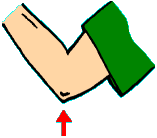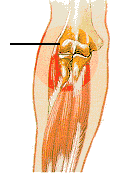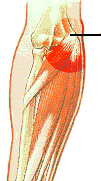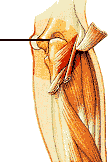















|

TENNIS ELBOW
Doctors first identified tennis elbow (or lateral epicondylitis) more than 100
years ago. Today nearly half of all tennis players will suffer from this
disorder at some point. Interestingly though, tennis players actually
account for less than 5 percent of all reported cases making the term for
this condition something of a misnomer. There are 2
additional strain related conditions which are often mistaken for Tennis
Elbow. These being Golfer's Elbow & Bursitis. Before we delve into the
details of what Tennis Elbow actually is and options that are available
for relieving & preventing the pain...let's look at the distinguishing
characteristics of each of these 3 ailments.
|
Tennis Elbow
(lateral epicondylitis) |
Golfer's Elbow
(medial epicondylitis)
|
Bursitis
|
|
Outside of Elbow
|
Inside of Elbow
|
Back of Elbow
|
|
Cause & Symptoms
The onset of pain, on the outside (lateral) of the elbow, is
usually gradual with tenderness felt on or below the joint's bony
prominence. Movements such as gripping, lifting and carrying tend to
be troublesome.
|
Cause & Symptoms
The causes of golfer's elbow are similar to tennis elbow but
pain and tenderness are felt on the inside (medial) of the elbow, on
or around the joint's bony prominence.
|
Cause
& Symptoms
Often due to excessive leaning on the joint or a direct blow
or fall onto the tip of the elbow. A lump can often be seen and
the elbow is painful at the back of the joint.
|
 |
 |
 |
Symptoms Of Tennis Elbow
-
Recurring pain on
the outside of the upper forearm just below the bend of the elbow;
occasionally, pain radiates down the arm toward the wrist.
-
Pain caused by
lifting or bending the arm or grasping even light objects such as a
coffee cup.
-
Difficulty
extending the forearm fully (because of inflamed muscles, tendons and
ligaments).
-
Pain that
typically lasts for 6 to 12 weeks; the discomfort can continue for as
little as 3 weeks or as long as several years.

The damage that
tennis elbow incurs consists of tiny tears in a part of the tendon and in
muscle coverings. After the initial injury heals, these areas often tear
again, which leads to hemorrhaging and the formation of rough, granulated
tissue and calcium deposits within the surrounding tissues. Collagen, a
protein, leaks out from around the injured areas, causing inflammation.
The resulting pressure can cut off the blood flow and pinch the radial
nerve, one of the major nerves controlling muscles in the arm and
hand.
Tendons, which
attach muscles to bones, do not receive the same amount of oxygen and
blood that muscles do, so they heal more slowly. In fact, some cases of
tennis elbow can last for years, though the inflammation usually subsides
in 6 to 12 weeks.
Many medical
textbooks treat tennis elbow as a form of tendonitis, which is often the
case, but if the muscles and bones of the elbow joint are also involved,
then the condition is called epicondylitis. However, if you feel pain
directly on the back of your elbow joint, rather than down the outside of
your arm, you may have bursitis, which is caused when lubricating sacs in
the joint become inflamed. If you see swelling, which is almost never a
symptom of tennis elbow, you may want to investigate other possible
conditions, such as arthritis, infection, gout or a tumor.
Relief Of Tennis Elbow
The best way to
relieve tennis elbow is to stop doing anything that irritates your arm — a
simple step for the weekend tennis player, but not as easy for the manual
laborer, office worker, or professional athlete.
The most effective
conventional and alternative treatments for tennis elbow have the same
basic premise: Rest the arm until the pain disappears, then massage to
relieve stress and tension in the muscles, and exercise to strengthen the
area and prevent reinjury. If you must go back to whatever caused the
problem in the first place, be sure to warm up your arm for at least 5 to
10 minutes with gentle stretching and movement before starting any
activity. Take frequent breaks.
Conventional
medicine offers an assortment of treatments for tennis elbow, from drug
injections to surgery, but the pain will never go away completely unless
you stop stressing the joint. Re-injury is inevitable without adequate
rest.
For most mild to
moderate cases of tennis elbow, aspirin or ibuprofen will help address the
inflammation and the pain while you are resting the injury, and then you
can follow up with exercise and massage to speed healing.
For stubborn cases
of tennis elbow your doctor may advise corticosteroid injections, which
dramatically reduce inflammation, but they cannot be used long-term
because of potentially damaging side effects.
Another attractive
option for many sufferers, especially those who prefer to not ingest
medication orally, is the application of an appropriate and effective
topical ointment.
CT Cream with
A.C.P.
was specifically designed to reduce inflammation and does so by taking
advantage of well known elements Arnica, Choline and Vitamin
B6.
If rest,
anti-inflammatory medications, and a stretching routine fail to cure your
tennis elbow, you may have to consider surgery, though this form of
treatment is rare (fewer than 3 percent of patients). One procedure is for
the tendon to be cut loose from the epicondyle, the rounded bump at the
end of the bone, which eliminates stress on the tendon but renders the
muscle useless. Another surgical technique involves removing so-called
granulated tissue in the tendon and repairing tears.
Even after you feel
you have overcome a case of tennis elbow, be sure to continue babying your
arm. Always warm up your arm for 5 to 10 minutes before starting any
activity involving your elbow. And if you develop severe pain after use
anyway, pack your arm in ice for 15 to 20 minutes and call your
doctor.
Prevention
To prevent tennis
elbow:
-
Lift objects with
your palm facing your body.
-
Try strengthening
exercises with hand weights. With your elbow cocked and your palm down,
repeatedly bend your wrist. Stop if you feel any pain.
-
Stretch relevant
muscles before beginning a possibly stressful activity by grasping the
top part of your fingers and gently but firmly pulling them back toward
your body. Keep your arm fully extended and your palm facing
outward.
Caution! To prevent a
relapse:
-
Discontinue or
modify the action that is causing the strain on your elbow joint. If you
must continue, be sure to warm up for 10 minutes or more before any
activity involving your arm, and apply ice to it afterward. Take more
frequent breaks.
-
Try strapping a
band around your forearm just below your elbow. If the support seems to
help you lift objects such as heavy books, then continue with it. Be
aware that such bands can cut off circulation and impede healing, so
they are best used once tennis elbow has disappeared.
Call Your Doctor
If....
-
The pain persists
for more than a few days; chronic inflammation of the tendons can lead
to permanent disability.
-
The elbow joint
begins to swell; tennis elbow rarely causes swelling, so you may have
another condition such as arthritis, gout, infection or even a
tumor.
© 1998-2000 Biomax Health Products, Inc.
www.tennis-elbow.net
IMPORTANT NOTE
The information on this website is general in nature and is only intended to provide
a summary of the subject matter covered. It is not a substitute for medical
advice and you should always consult a trained professional practising in the
area of sports medicine in relation to any injury. You use or rely on
information on this website wholly at your own risk and no party involved in the
production of this website accepts any responsibility for the information
contained on it or your use of that information.
|
|